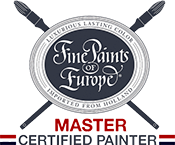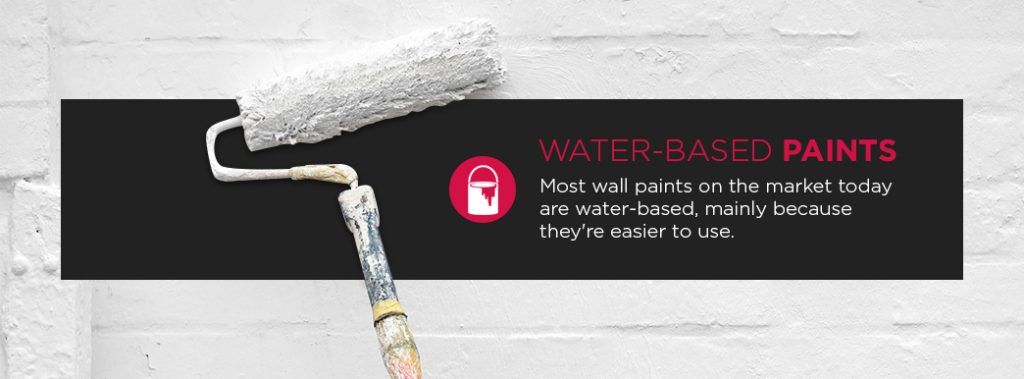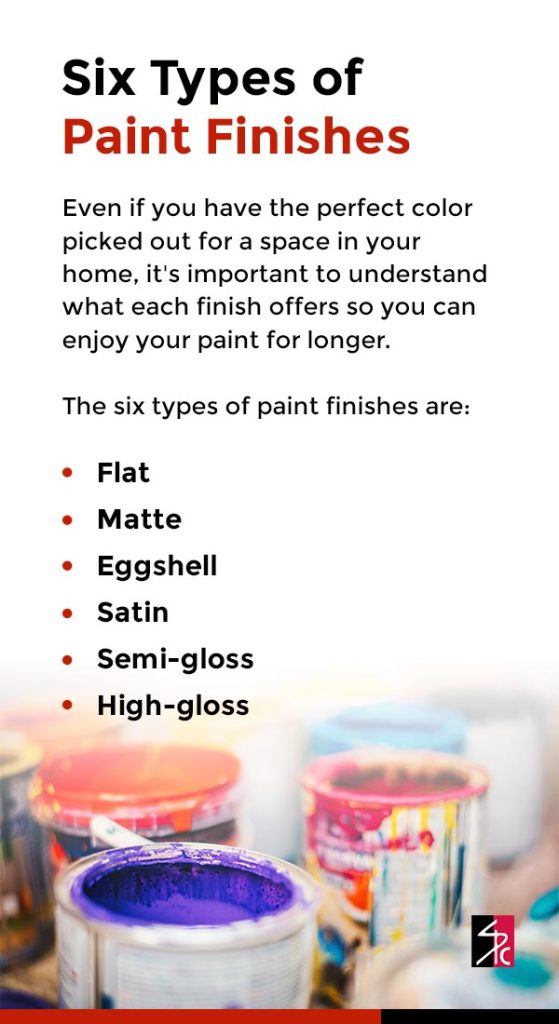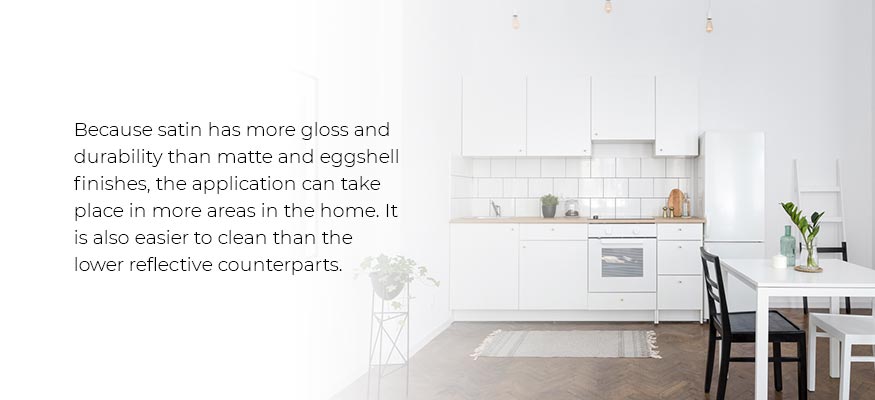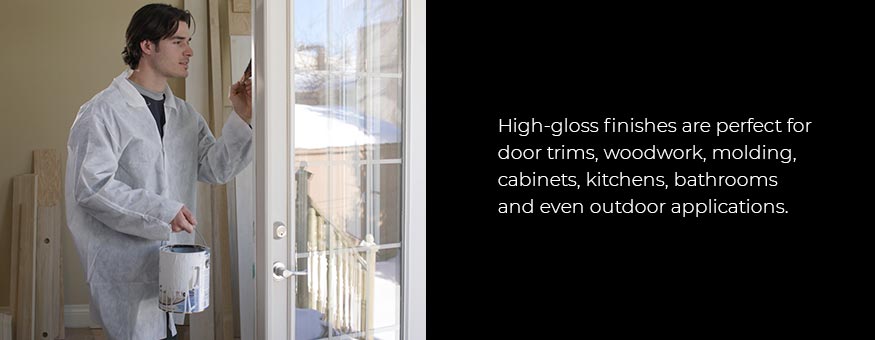A Guide to Choosing the Perfect Paint Finish for Your Home
May 14, 2024
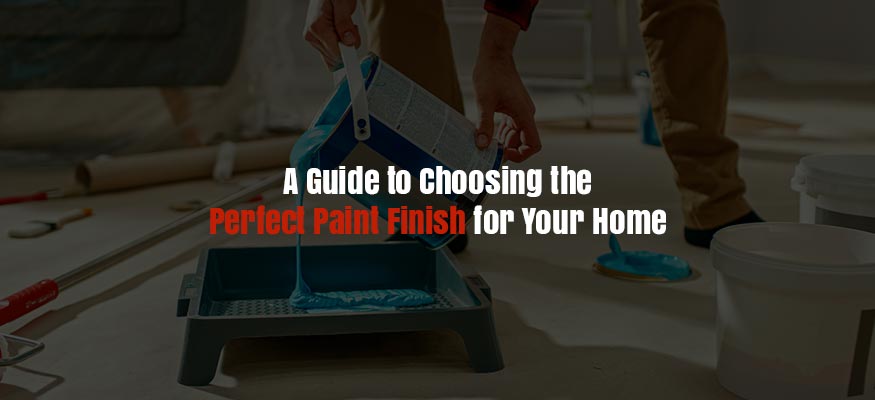
After months of living in a new apartment or home, you’ve been meaning to paint your walls to bring a little more character into your living space. Perhaps you’re looking for durable paint selections because you plan to stay long-term, or maybe you want the right color to boost a room’s character.
The paint you choose for your walls can make all the difference in how your residence looks and feels. The durability and protection that different paints offer are also important factors when choosing the right color and finish for your home.
For the basics, the higher the sheen of the paint finish, the higher the shine and ability to reflect light. Flat and matte paints offer no light reflectivity, while semi-gloss and high-gloss paints reflect light, giving them a slight shine. Depending on what you decide will suit your room, several finish options can offer the perfect sheen to fit your style preferences.
Considerations for Types of Paint Finishes
While picking the color of your paint might seem like the most important task when planning how the room will look overall, choosing the right sheen is just as critical. The gloss in each determines how the color appears to the naked eye, the paint’s durability and the ability to hide imperfections.
Before selecting a sheen based on appearance, you can also consider the following factors in or about your home:
- Type of room: Bathroom and kitchen cabinet and wall paint applications are susceptible to water, humidity, soap and even grease from cooking. Picking a finish that protects your walls from these elements is essential.
- Foot traffic: Walking in and out of rooms consistently for years can impact the shine of your walls without a highly durable paint finish.
- The texture of the walls: Depending on which route you go, your wall’s texture might interfere with the paint application. The flatter the finish you select, the more the paint will hide the imperfections and nuances of the wall’s texture. For cracking walls, picking a flat or matte finish might be the best choice.
- Natural light and room size: When selecting a sheen, consider how much natural light comes into a room and the feeling you want to convey visually. The low reflectivity of flat finishes can help give the appearance of a wall receding, while the higher-gloss finishes will allow more light to bounce across the room.
- Uses for the room: When it comes to the room’s purpose, it’s important to choose the right paint finish for more practical applications, such as normal wear and tear, and consider how easily it will be to clean. For a wall that’s easiest to clean, go for the higher sheen.
- Opt for higher-quality paints if your budget allows. Paints that are high-quality generally have higher pigment levels. This allows the paints to more thoroughly cover surfaces with fewer coats. High-quality paints also contain higher amounts of resins, which make the paint more durable.
- Consider how easy it is to clean: The glossier your paint, the easier the cleaning will be.
- Test it out: For peace of mind, test out the color and sheen you’re considering. Pick out a sample and apply it to a small area of the surface to make sure you’re choosing the right paint for your application.
- Don’t forget about the colorant and tint base: The colorant determines the degree to which the paint fades over time. White and brown, for instance, generally fade less quickly than yellows and bright greens. The tint base serves to form a color’s foundation and helps to determine the toughness of the paint as well as its resistance to stains and dirt. It also determines its ability to hold up when scrubbed.
Water-Based or Oil-Based Paint?
Another decision you’ll have to make is whether you want water- or oil-based paint.
Water-Based Paints
Most wall paints on the market today are water-based, mainly because they’re easier to use. If you’re planning to use a water-based product on a surface where an oil-based paint was previously applied, the water-based product might not be able to adhere properly. In this case, we recommend that you wash your surface and then roughen it using sandpaper that is medium or smooth grit. This will prevent the new coat from peeling.
For times when oil-based products would be traditionally preferable but you’d like to use water-based paint instead, you can take advantage of “waterborne alkyds” or “waterborne enamels,” which several companies have developed just for this purpose. These products contain excellent leveling qualities and behave very similarly to oil-based paints.
Some pros of water-based products include the following:
- No pre-treatment is required.
- Mildew won’t grow on them.
- Toxic emission levels are low.
- The cleanup is easy.
- It dries quickly.
- Their flexible, elastic finish makes them crack-resistant.
- They can be used on most surface types.
- They don’t fade in the sunlight.
Oil-Based Paints
Paints that are oil-based can be applied to most surfaces and are known for their rich finish and durability. However, use caution when working with oil-based paints, as they release fumes that are strong and sometimes overwhelming. You can’t wash them with water and instead must use turpentine or another solvent to wash brushes and other painting materials.
Benefits of oil-based products include:
- They have a visually appealing gloss.
- They’re a good choice for kitchens, bathrooms and other spaces with high levels of moisture.
- They take longer to dry, which allows you to make fixes.
- They form a durable, hard finish.
Six Types of Paint Finishes
Even if you have the perfect color picked out for a space in your home, it’s important to understand what each finish offers so you can enjoy your paint for longer.
Flat & Matte Paint
Flat paint finishes, also known as matte finishes, provide a uniform, smooth appearance and are the most popular choice for painting interior walls. Deriving their name from their complete lack of shininess, they are excellent options for older ceilings and walls with imperfections that you want to hide, including nail holes, patches and dents. Applying flat finishes is easy and can be done with a roller or brush.
One of the biggest cons of flat finishes is that they’re easy to mark up. While you can remove some marks using a wet cloth, you will need to regularly retouch walls with a matte finish.
Where Should You Use Flat or Matte Paint?
If you have pets or children, you may want to avoid a flat finish on the walls as it is the most difficult to clean. However, the nature of the paint sheen is to soak up the light, providing no reflectivity. This feature allows you to hide imperfections in your walls. Because they have more pigment, they take less work to cover and are the most economical selection for covering large spaces in the home.
For those who do not wish to cover the cost of a more expensive sheen, matte finishes offer the most cost-effective solution to bring that perfect aesthetic to your home.
Flat finishes work best in spaces that are more formal, including:
- Living rooms
- Dining rooms
- Ceilings
- Bedrooms
- Any place where you’re not too concerned about messing up the paint
While flat finishes were once commonly used on exteriors, this is no longer the case today. The flat finish is porous, matte and prone to mildew issues and fading. If you’re like most customers, you’ll probably want an exterior paint finish that’s more durable and shinier, but this doesn’t mean you have to rule out flat paint completely.
Eggshell Paint
The eggshell finish provides surfaces with a soft and washable appearance that looks great in family rooms, hallways and living rooms. Its name comes from the unique texture it gives to a surface, which resembles that of an eggshell if viewed from certain angles in the light.
Eggshell finishes have a very subtle shine that lacks the smoothness of satin finishes. This means it doesn’t bring out imperfections as much as satin, making it a more appropriate finish for interior walls. It’s also more durable and easier to clean than a surface with a flat finish.
Where Should You Use Eggshell Paint?
Like a flat finish, eggshell is best utilized for areas with low traffic and not susceptible to dirt. In addition, if you have pets or children, cleaning is not as easy with eggshell paint. If you plan on using an eggshell finish, consider the texture of your walls.
It coats surfaces very nicely as well, meaning you can’t see any roller edges, spray marks or brush strokes after it’s applied. If you’re going to repaint the siding on your home and would like a finish that has low reflectivity and hides small imperfections, you will want to consider an eggshell finish. It’s also good for subtly bringing out details in the trim.
An eggshell paint finish is the best for:
- Bedrooms
- Living rooms
- Family rooms
- Hallways
Eggshell paint also works well on a wide variety of exterior siding types, including horizontal wood, stucco and various others. In fact, it’s the most common exterior finish for bodies of homes. It can be washed easily with power washing and is also effective at concealing minor imperfections beneath the coating. This finish can also offer protection from rain, snow and seasonal changes in the weather.
Satin Paint
A satin finish provides a surface with a soft, low sheen and is one of the best finish types for interior and exterior applications. It has a strong resistance to mildew and can be cleaned with just a light scrubbing or wiping, making it a good choice for surfaces you’ll need to clean regularly. However, as is the case with glossier finishes, you should avoid using satin paint on surfaces with lots of imperfections as it will make them stand out more.
Where Should You Use Satin Paint?
Because satin has more gloss and durability than matte and eggshell finishes, the application can take place in more areas in the home. It is also easier to clean than the lower reflective counterparts. It is ideal for more active rooms in the house and can even be used outdoors due to its higher durability. Consider the room where the satin paint will go. Unlike eggshell or matte paints, satin does not hide imperfections and can show an uneven application.
Satin finishes work well in the same areas as eggshell finishes, which include high-traffic areas like living rooms, hallways, bedrooms and family rooms. However, since it is harder-wearing than an eggshell finish, it is also one of the best paint finishes for areas such as:
- Basements
- Kitchens
- Children’s bedrooms
- Dining rooms
- Bathrooms
- Trim, if the satin finish is sufficiently tough
As for your exterior, a satin finish is a good choice for homes in sunny, hot climates because it has a higher amount of UV protection. It’s also good for humid climates since it resists mildew. This finish works best on areas that you use or touch often, but keep in mind that a satin finish tends to highlight dings, dents, ridges and cratering in wood siding and trim that is older. That means it is best to use it on siding that is new or in decent condition. Satin finishes are also ideal for areas like:
- Soffits
- Eaves
- Trim boards
- Door frames
- Porch ceilings
- Window sills
- Shutters
Low-Gloss or Semi-Gloss Paint
Semi-gloss finishes are shinier than satin but less shiny than high-gloss. Just like high-gloss finishes, semi-gloss finishes also give walls a shiny look and are known to brighten up rooms. They’re especially effective at brightening up paler shades of light colors and off-whites. However, their shininess also makes them more suitable for trim than walls. One benefit that semi-gloss offers over high-gloss is that semi-gloss paint can usually cover your surface adequately with just one coat.
Where Should You Use Low-Gloss Paint?
If you are having trouble deciding if low-gloss paint is right for you, consider the walls’ texture and the room’s purpose. Low-gloss finishes are highly durable and ideally suited to high-traffic areas of the home. They also provide better resistance to stains and damage.
Semi-gloss finishes are also known for their moisture resistance, making them perhaps the best paint finish for bathrooms, kitchens and other humid places. To clean surfaces that have a semi-gloss finish, all you have to do is wipe or lightly scrub them, which makes them easier to clean than surfaces with other finishes.
Semi-gloss finishes tend to work well for the following interior areas:
- Windows
- Doors
- Trim
- Kids rooms, if you happen to like the shiny look
- Kitchens and bathrooms, once again, depending on your tastes
When it comes to home exteriors, semi-gloss finishes provide homes with a visible shine and are best suited for areas that need to be cleaned frequently. They can also withstand harsh weather and large amounts of moisture. However, although it is a good option for trim detail, a semi-gloss finish isn’t recommended if you want to hide chips, cracks or other imperfections on a surface.
Semi-gloss finishes are most suitable for the following exterior features:
- Front doors
- Garage doors
- Trim
- Shutters
- Gutters
- Railings
- Lamp posts
- Window sills
High-Gloss Paint
High-gloss finish provides the greatest reflection level and is commonly used for accents. Although it can be used on walls, many homeowners prefer it more for woodwork due to its shininess. Keep in mind, however, that high-gloss paint brings attention to all of a surface’s imperfections.
High-gloss finishes tend to require more coats than lower-sheen finishes and usually involve more preparation, like sanding the surface. High-gloss paints also require more time to dry, which means you’ll have to allow several hours for drying time in between coats. You can use a fan to speed up the drying process.
Where Should You Use High-Gloss Paint?
A high-gloss finish is a popular choice for the following interior areas of your house:
- Trim
- Furniture
- Molding
- Cabinets
- Interior doors
- High-traffic areas
- Almost anywhere you’d like a distinctive atmosphere
High-gloss finishes are perfect for door trims, woodwork, molding, cabinets, kitchens, bathrooms and even outdoor applications. Since it is the most durable type of paint available, you can also count on the longevity of the application. If you plan on staying in your home for many years, consider the benefits of applying high-gloss paint to high-traffic areas that will see dirt and damage. Due to the highly reflective nature of the paint, hiring a professional to apply it is a better choice, as it is challenging to maintain an even coat. The imperfections of the application will be far more noticeable when compared with flat, eggshell, satin or even semi-gloss finishes.
Comparing the Different Finish Options
Now that you have a better idea of which type of paint finish goes best in certain rooms, let’s see how each one compares to the others. Explore these paint finish comparisons to see which one is best for you and your home.
Difference Between High-Gloss vs. Low-Gloss Paint
High-gloss paint provides more durability and higher reflectivity than low-gloss paint. While many of the same areas of the home are both suited to low-gloss and high-gloss applications, consider the benefits of each and what you’re trying to achieve before selecting a finish. High-gloss finishes might be the best choice for areas like bathrooms and kitchens. However, specific living spaces may call for low-gloss paint, such as hallways, foyers and indoor applications.
Difference Between High-Gloss vs. Eggshell vs. Satin Paint
The most significant differences between high-gloss, eggshell and satin paints are reflectivity, ease of cleaning and durability. With this in mind, high-gloss paints may not work in the same living spaces as eggshell paints. Eggshell paints are best for walls and low-traffic areas of the house because they are harder to clean effectively. Satin is a nice middle ground between high-gloss and eggshell finishes, and might be the best choice if you are trying to determine if the aesthetic is more important than longevity.
Difference Between High-Gloss vs. Matte Paint
The difference between matte and high-gloss finishes is night and day. Matte finishes have no light reflectivity, while high-gloss offers the highest light reflection available regarding sheen. Compared to high-gloss finishes, matte paints are the least durable and the hardest to clean. However, in rooms with little traffic and areas such as ceilings, matte finishes offer an elegant, smooth sheen and are more economical than high-gloss paints.
Imperfections in the walls are no match for matte finishes, which have a very high amount of pigment. Matte finishes offer the best way to hide those imperfections with a fresh coat that covers surfaces easily. High-gloss paints are very reflective and require our professional painters to apply them to specific areas of your home.
Difference Between Satin vs. Semi-Gloss Paint
The main difference between satin and semi-gloss paints is the quality and quantity of sheen in each can. Semi-gloss paints have more of a sheen than a satin paint finish. The extra sheen can change how paint colors look on your wall because a semi-gloss surface will reflect more natural and artificial light.
Additionally, semi-gloss is more durable and easier to clean. Still, satin finishes are more forgiving regarding pre-existing imperfections on your walls. When deciding on the type of paint to choose, it’s important to consider the space it will go in, the light sources and the foot traffic in the room.
Difference Between Eggshell vs. Satin Paint
The difference between eggshell and satin finishes is the texture and appearance. Eggshell offers little to no shine while providing a unique texture similar to real eggshells. In contrast, satin looks like a velvet shine that gives your walls an elegant appearance.
Eggshell is a great paint option for rooms with medium foot traffic, like gathering areas, while satin can withstand more elements such as grease, moisture and heat. Since satin has a higher sheen, this finish offers more durability. Depending on the room, you can decide whether durability is at the top of your priorities.
Request a Consultation Today
With this information about paint finishes and sheens at your fingertips, it’s time to turn your vision into reality. If you live in the New York or Connecticut areas, contact Shoreline Painting to request a consultation for your newest painting project.
Not sure where to start? Explore our completed interior and exterior painting projects for additional inspiration. Our team of professional painters and expert staff is happy to offer guidance on what type of paint sheen to use and much more.
Recent Posts & Guides





